- Slug: BC-CNS-Warming Arizona,2700
- Note: This package is designed to run in its entirety or as a three-part series.
- Photos available (thumbnails, captions below)
By GRANT MARTIN
Cronkite News Service
It’s the year 2100.
A nine-mile paved loop in the Sonoran Desert outside Tucson is the only evidence of Saguaro National Park, which was shut down after its last surviving cactus was finally suffocated by an invasive grass.
In Flagstaff, chairlifts transport skiers above barren mountainsides, while the formerly individual trails below having been forced into an indistinct snowy expanse by a recent fire that wiped out thousands of acres of forest.
Millions of families in Phoenix and Tucson drink desalinated ocean water routed in canals from Mexico and California, a costly but necessary means of compensating for decades of drought that had drained the supply previously provided by the Colorado River.
These are just a few of the possibilities that experts from around the state offered when Cronkite News asked them how Arizona’s forests, deserts and major metropolitan areas might look at the end of the century given generally accepted rates of global warming.
Experts interviewed for this project based the possible outcomes on a projected increase in average annual temperature of 6 degrees Fahrenheit by the end of the century.
While each offered a different perspective and prediction for the future, all of the scientists interviewed agreed that Arizona must adapt quickly and with sensitivity toward an uncertain future.
Arizona without saguaros? Drought, plant invaders pose threats
TUCSON – Saguaro National Park boasts breathtaking views, its undulating landscape studded with thousands of its namesake cactuses. It’s a sight as spectacular as it is uniquely Arizonan, as no other state can claim nearly as much habitat for the towering saguaro.
In turn, Arizona has embraced the saguaro as an unofficial state symbol – there are five on its license plates, and a saguaro features prominently on the state’s quarter design – and state law imposes fines of up to $250,000 on anyone convicted of destroying one.
Such protections, however, could prove futile in the face of sweeping ecological changes brought on by rising temperatures.
University of Arizona researchers Jeremy Weiss and Jonathan Overpeck assert that projected droughts and the decreased frequency of freezing temperatures might make the desert uninhabitable for some of its most iconic vegetation.
“You have to have a fair bit of summer precipitation, like the monsoons in the Sonoran Desert,” Weiss said in an interview. “Species like the saguaro and palo verde can’t survive in other deserts like the Mohave in southeastern California because it’s just too dry over there.”
Freezing temperatures, meanwhile, are a paradoxical boon to native vegetation. Saguaros have thrived here for centuries largely because of an ideal thermal balance: warm and moist enough for most of the year to facilitate growth, but just cold enough in the winter to inhibit the intrusion of competitive, non-native species.
“We’re seeing fall freezes come later, we’re seeing the last spring freeze come earlier, and we’re seeing a fewer number of freezes during the winter,” Weiss said. “Now the question is, how does this less limiting environment affect where we find certain types of vegetation in the state?”
Julio Betancourt, a researcher for the U.S. Geological Survey in Tucson, believes the answer is already making its presence felt in the expanses between vegetation in the Sonoran Desert.
“These bare spaces are critical,” Betancourt said. “I can go out in the desert and walk up to a saguaro with a can of gasoline, pour it over it, set it ablaze, and the fire’s not going to spread, simply because there’s so much bare ground and so little continuity in fuel.”
Without freezing temperatures to check their advance, however, invasive species of vegetation – most notably an African weed called buffelgrass – are filling these bare spaces and creating unprecedented fire risks in the Sonoran Desert.
“Now what’s happening,” Betancourt said, “is we have these non-native species, such as buffelgrass, spreading and creating heavy fuel for fires in areas that have never before burned. And because the native shrubs and cactuses are so poorly adapted to fires, they don’t really recover from fires but are instead displaced by the invasive grasses.”
Buffelgrass and other invasive species also threaten native vegetation by absorbing crucial moisture and nutrients from the ground as they spread, effectively suffocating saguaros and palo verdes.
Asked about how the landscape might be different 100 years from now, Betancourt pointed to Saguaro National Park.
“In a hundred years, I wouldn’t be surprised if it’s called Buffelgrass National Park,” he said.
Buffelgrass was first introduced to America in the 1930s on ranches in the Southwest as an inexpensive, self-sustaining food for cattle. It was deliberately introduced to the Sonoran Desert shortly afterwards as a means of combating erosion. Buffelgrass and red brome, another non-native grass, were the primary catalysts of the 2005 Cave Creek Complex fire, which charred nearly 250,000 acres of desert north of Phoenix.
At a ranger office in Saguaro National Park, a stalk of buffelgrass is taped to a piece of posterboard, its attributes and identifying features clearly labeled. It’s one of the first things new rangers at the park must study.
“We try to be as vigilant as we can with the resources we have,” said Dana Backer, a resource ecologist at the park. “It’s an enormous concern, and it’s something we take very seriously.”
During summer months, when buffelgrass spreads most quickly, teams of rangers and volunteers trudge up the park’s hillsides each morning wearing masks and gloves and carrying herbicide containers on their backs. Once a stand of buffelgrass is identified, it’s sprayed with chemicals and dyed blue to track progress.
“It’s awfully uncomfortable, especially once the sun comes out, but it’s work that needs to be done,” said Backer, who estimated that 2,000 acres of buffelgrass had already invaded the park.
“But frankly, it’s moving faster than we can keep up with it,” Backer said.
From pines to prairie? Arizona’s forests susceptible to fire, beetles
FLAGSTAFF – Drivers headed northwest along U.S. Route 180 from Flagstaff to the Grand Canyon travel through an eerie landscape amidst the otherwise lush and verdant Coconino National Forest.
Charred trunks protrude from a grassy savannah, thin skeletons of the towering ponderosa pines that had dominated these hillsides. Blackened tree limbs are scattered among them. There are barely any patches of green here, and there are no sounds of wildlife.
It resembles nothing so much as a graveyard.
Arizona forestry experts fear such landscapes might be increasingly common over the next century, as warmer temperatures and drier weather create virtually ideal conditions for wildfires. Such fires have already ravaged hundreds of thousands of acres of Arizona’s forests in the past few decades.
“We’re already seeing fires of increased frequency and intensity,” said Tom Kolb, a professor at Northern Arizona University’s School of Forestry in Flagstaff.
“Conditions here are definitely more hot and dry than they were a hundred years ago, and that’s contributing to the fires that have become almost an annual occurrence around here.”
This summer, a blaze swept through over 15,000 acres of the Coconino National Forest, threatening homes and destroying wildlife habitat. The damage is just a fraction of that caused by 2002’s catastrophic Rodeo-Chediski Fire, which consumed over 450,000 acres in the White Mountains, forcing the evacuations of Show Low and other nearby communities.
Recent though the devastation along Route 180 may appear, it’s actually evidence of a wildfire that occurred in 1996. There has been scarcely any regeneration of the vegetation that had thrived here prior to that fire, and experts believe it may take several decades – if ever – before any significant new growth restores natural beauty to these hills.
“Ponderosa pines reproduce only by seeds,” explains Pete Fule, an ecological restoration expert who also teaches at NAU. “These seeds can only carry a certain distance away from parent trees, so when you have a large disturbance event that kills trees over a pretty big area, it’s difficult for them to regenerate back into that site.”
As wildfires continue to eliminate the ponderosa pine and other native trees from their habitat in Arizona, they create an opportunity for invasive species such as bromus tectorum, commonly called “cheatgrass,” to take their place. Cheatgrass has supplanted the native vegetation in many wildfire sites throughout northern Arizona, essentially transforming forests into prairies.
Because cheatgrass is itself very flammable, these resulting savannahs are veritable tinderboxes for the surrounding forests, providing fuel that will only add to the intensity of future fires.
At least one recent study suggests that the proliferation of grassy plains in areas previously occupied by forest vegetation – such as the transformation evident along Route 180 – is to be expected.
Fule explained that a third of large wildfire sites throughout the Southwest in the past half century never returned to their original conditions.
Fire is hardly the only agent of change affecting Arizona’s forests as temperatures climb over the next 90 years.
Pine bark beetles, already responsible for the deaths of millions of pinyon and ponderosa pines in the state, reproduce at a faster rate in warmer weather. U.S. Interior Secretary Ken Salazar has referred to these beetles as “the Katrina of the West,” and their devastation might just be beginning. Healthy pines are able to defend themselves against infestation by pushing the beetles out with sap, but droughts weaken trees, rendering them more vulnerable to attacks.
Such droughts would also threaten Arizona’s spruces, firs and aspens, which rely on moisture more than pines. Such species thrive today in moderately moist habitats such as the temperate hardwood forests around the White Mountains.
Also, as Arizona’s forests become increasingly warm, existing vegetation may relocate, especially at higher elevations, to areas more favorable to their growth. For instance, junipers and pinyon pines – two trees typically found in Arizona’s low-lying woodlands, could conceivably adapt to climate change by moving upwards in elevation to more moderate conditions, supplanting ponderosa pines in the process.
Fule, quipping that “plants aren’t really good at walking,” doubts whether the native vegetation can relocate quickly enough to adapt to the changing climate. If this proves to be the case, the vegetation in low-lying areas might simply die off.
“The key point about modern climate change,” Fule said, “is that it’s happening very quickly. It seems unlikely that modern ecosystems, just acting through natural processes of regeneration, would be able to keep up. In fact, people have done modeling studies to look at how fast plants would have to move, and it’s pretty darn fast. It’s something that exceeds, by orders of magnitude, the fastest movement of plants that we’ve ever seen in the fossil record.”
Kolb’s office looks out over a nearby hill resplendent with healthy ponderosa pines. Asked what he would expect to see were he to look out his window in 100 years, Kolb conjectured that the hillside would have fewer ponderosas and more junipers and pinyons, species that would have crept up in elevation to adapt to the rising temperatures.
Then he turned away from the window and shrugged.
“If it doesn’t look like that,” Kolb said, “then it might just be an ugly, burned landscape out there.”
Rising temperatures threaten cities’ air quality along with water supplies
PHOENIX – In the mid-20th century, this city experienced a population boom as people moved here from across the country, seeking the health benefits to be derived from a mild climate and low pollen count. Over the next century, however, a confluence of factors – each tied to climate change – threaten this quality of life.
From the summit of nearby Camelback Mountain, one can often see a thick blanket of smog enveloping the downtown area. As the temperature rises over the next century, experts say, the air quality will deteriorate even further, potentially causing serious health problems for many area residents.
Anthony Brazel, a climatologist at Arizona State University’s School of Geographical Sciences and Urban Planning, offers a dire forecast for the region’s air quality.
“There are already a number of studies worrying about livability and air quality,” Brazel said, “and as it gets hotter it’ll exacerbate ozone problems and ultraviolet radiation, especially during the summer months.”
Brazel has conducted extensive research on the “urban heat island” phenomenon, which suggests that Phoenix will heat at an even faster rate than its surroundings over the next century.
“Buildings, cement, asphalt, those sorts of infrastructure parts absorb a fair amount of heat during the day and release it at night,” Brazel said. “Already, since the middle of the 20th century, nighttime temperatures during the summer months here have risen by about 10 degrees Fahrenheit.”
Such temperatures will place an even higher premium on air conditioning in homes, driving up energy costs. Low-income residents may not have the resources to maintain a reasonable quality of life within their homes.
The heat island effect may be mitigated by a variety of measures, such as providing for more shade, reflective surfaces on buildings, thermally efficient construction materials and naturally green expanses such as parks.
But those steps could be moot in the face of an impending crisis of water availability.
A recent study by University of Arizona scientists Jonathan Overpeck and Bradley Udall projects that the average annual flow of the Colorado is projected to decrease by as much as 20 percent by 2050.
Even with conservation and re-use of its existing water supply, Arizona may be forced to rely on desalinated ocean water, requiring a canal construction project unprecedented in scale or expense.
Without sufficient water or cooling mechanisms, millions could conceivably leave cities like Phoenix and Tucson for more habitable climes.
“If it becomes too hot here, what happens if there’s a heat wave?,” asked Darren Ruddell, a researcher at Arizona State University’s Global Institute of Sustainability.
“Lots of people are going to die, lots of people are going to become sick and frankly a lot of people are going to leave,” he said. “And so we need to design cities more efficiently to reduce human vulnerability to climate change and heat stress.”
Ruddell asserts that water conservation is a critical means of ensuring the future viability of Arizona’s cities.
“Right now, about 65 percent of Phoenix’s residential water use is for outdoor purposes,” he said. “That’s our irrigation, that’s our pools, that’s our lawns, and that’s the kind of wastefulness that will need to be addressed in the future.”
Already, the cities of Mesa and Tempe are offering $500 subsidies to homeowners who convert their yards from grass to turf or gravel.
Though Ruddell remains unconvinced that the program will be viable in the long term – he believes the cooling effect of natural grass is more vital than the benefits of water conservation – the measures suggest that the issue of water scarcity is already on local city planners’ minds.
It’s also important for architects to take such considerations into account when designing new buildings in Arizona’s urban areas, according to Harvey Bryan, a sustainability scientist at ASU’s School of Architecture.
“No one knows how to use glass these days,” said Bryan. “Sure, it looks pretty, but it can be incredibly wasteful.”
Because of the amount of light and heat that glass lets into a building, it drives up energy costs associated with cooling the interior at a rate that may not be sustainable.
According to Bryan, architects should incorporate such methods by incorporating more vegetation along building exteriors, painting rooftops to better reflect heat instead of absorbing it and designing larger rooms to allow for better circulation of air.
As Phoenix adapts to accommodate each of these recommendations and considerations into its infrastructure and architecture, the view in 90 years from Camelback Mountain will likely reveal a city far better adapted to the challenges and social responsibilities brought about by climate change.
^___=
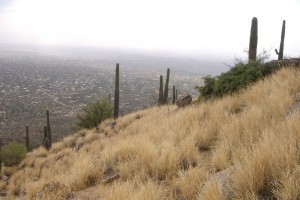
Buffelgrass blankets an area of the Santa Catalina Mountains near Tucson. Researchers say warming temperatures and fewer winter freezes are helping the invasive plant spread, posing a threat to saguaro cactuses and other native plants. (Photo by Aaryn Olsson, University of Arizona)

The namesake cactus of Saguaro National Park in Tucson. (Cronkite News Service Photo by Grant Martin)

Saguaro National Park in Tucson is a haven for native plant species such as the saguaro cactus. (Cronkite News Service Photo by Stephanie Sanchez)
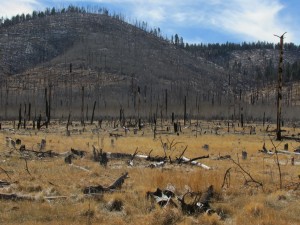
Researchers say this area of the Coconino National Forest, which burned in 1996, is decades away from returning to its native state, if it ever does. They say rising temperatures have weakened trees, raising the potential for devastating wildfires that will open the door to invasive species. (Cronkite News Service Photo by Grant Martin)
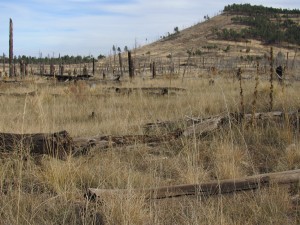
Grass grows in an area of the Coconino National Forest burned in a 1996 wildfire. (Cronkite News Service Photo by Grant Martin)
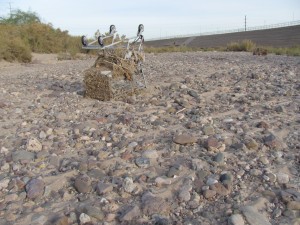
The Santa Cruz River runs dry through Tucson. Researchers say that water availability will be among the challenges Arizona’s urban areas will face as warming temperatures cut existing supplies. (Cronkite News Service Photo by Grant Martin)

The Central Arizona Project aqueduct traverses the desert west of Phoenix. Reduced supplies projected for the Colorado River watershed could require an even greater public works project to bring in desalinated ocean water. (Photo by the U.S. Bureau of Reclamation)
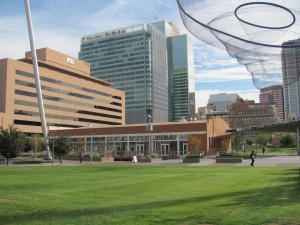
Urban planners say green spaces such as Civic Space Park in downtown Phoenix can help mitigate the effects of warming temperatures in Arizona’s cities. (Cronkite News Service Photo by Grant Martin)